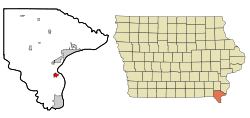Montrose, Iowa
| Montrose, Iowa | |
|---|---|
| City | |
 |
|
 Location of Montrose, Iowa |
|
| Coordinates: 40°31′46″N 91°24′58″W / 40.52944°N 91.41611°WCoordinates: 40°31′46″N 91°24′58″W / 40.52944°N 91.41611°W | |
| Country |
|
| State |
|
| County | Lee |
| Area | |
| • Total | 1.14 sq mi (2.95 km2) |
| • Land | 1.12 sq mi (2.90 km2) |
| • Water | 0.02 sq mi (0.05 km2) |
| Elevation | 531 ft (162 m) |
| Population (2010) | |
| • Total | 898 |
| • Estimate (2012) | 878 |
| • Density | 801.8/sq mi (309.6/km2) |
| Time zone | Central (CST) (UTC-6) |
| • Summer (DST) | CDT (UTC-5) |
| ZIP code | 52639 |
| Area code(s) | 319 |
| FIPS code | 19-53760 |
| GNIS feature ID | 0459199 |
Montrose is a city in Lee County, Iowa, United States. The population was 898 at the 2010 census. The town is located on the Mississippi River. It is part of the Fort Madison–Keokuk, IA-MO Micropolitan Statistical Area.
The area around Montrose has been occupied continuously since at least the 1780s, when Quashquame's village was established nearby. The area was strategically important because it is at the head of the Des Moines Rapids, a major impediment to river traffic that caused large boats to land in this area and transfer freight overland to avoid the rapids. Montrose was the location of Fort Des Moines No. 1, a military post from 1834-1837. From 1839-1846 Montrose was the home of many members of the Church of Jesus Christ of Latter Day Saints. This was especially true in 1839 when many people lived in an abandoned barracks at Montrose that served as a good short term residence while homes were being built in Nauvoo. Among Montrose's residents at this time were Brigham Young, Wilford Woodruff and Erastus Snow. Despite legends that the streets of Montrose were aligned to allow a direct view of the Nauvoo Temple across the Mississippi River in Illinois, the streets actually align with the 1834 layout of Fort Des Moines.
Montrose's longitude and latitude coordinates
in decimal form are 40.529532, -91.415995.
According to the United States Census Bureau, the city has a total area of 1.14 square miles (2.95 km2), of which, 1.12 square miles (2.90 km2) is land and 0.02 square miles (0.05 km2) is water.
...
Wikipedia
